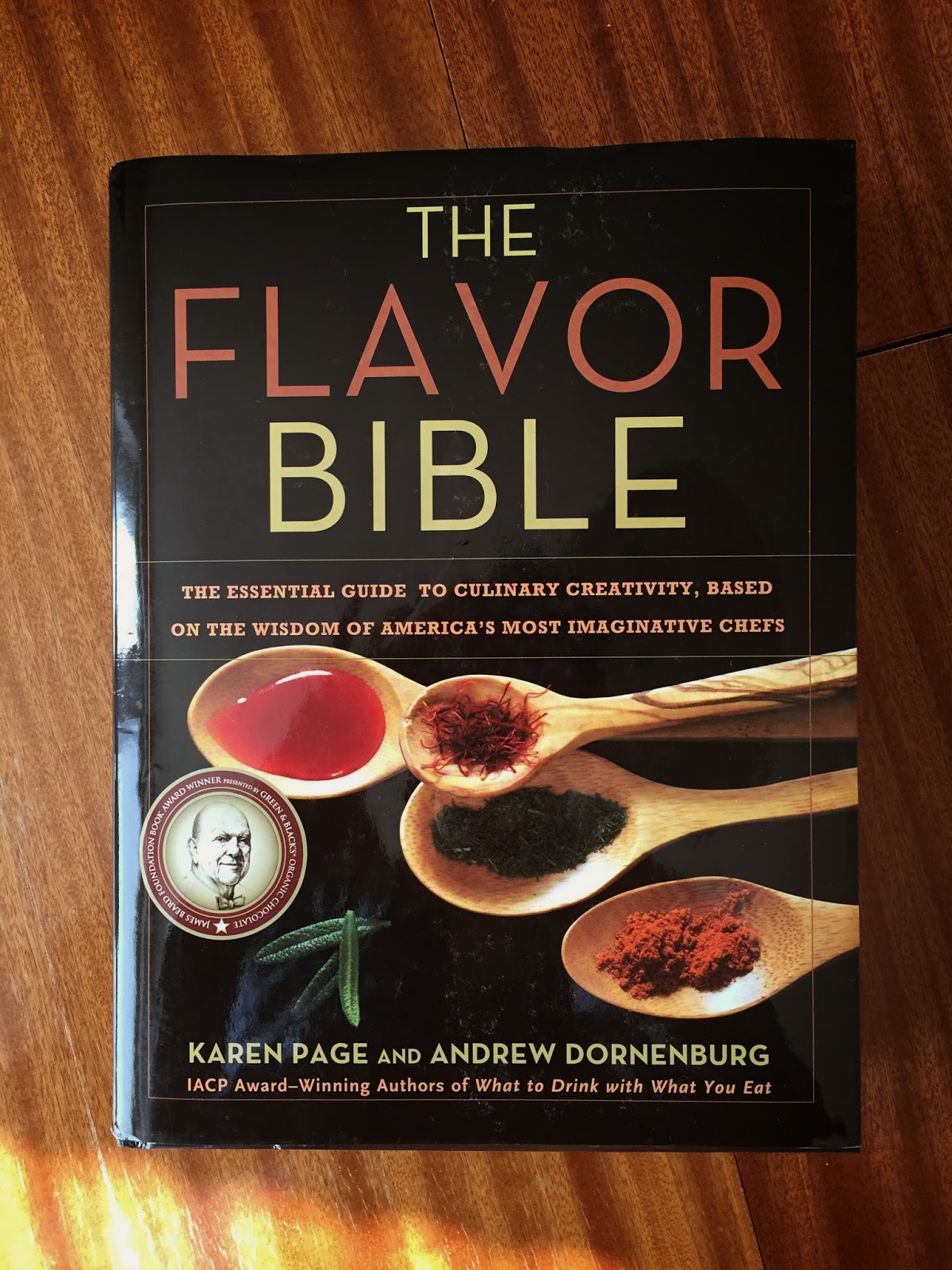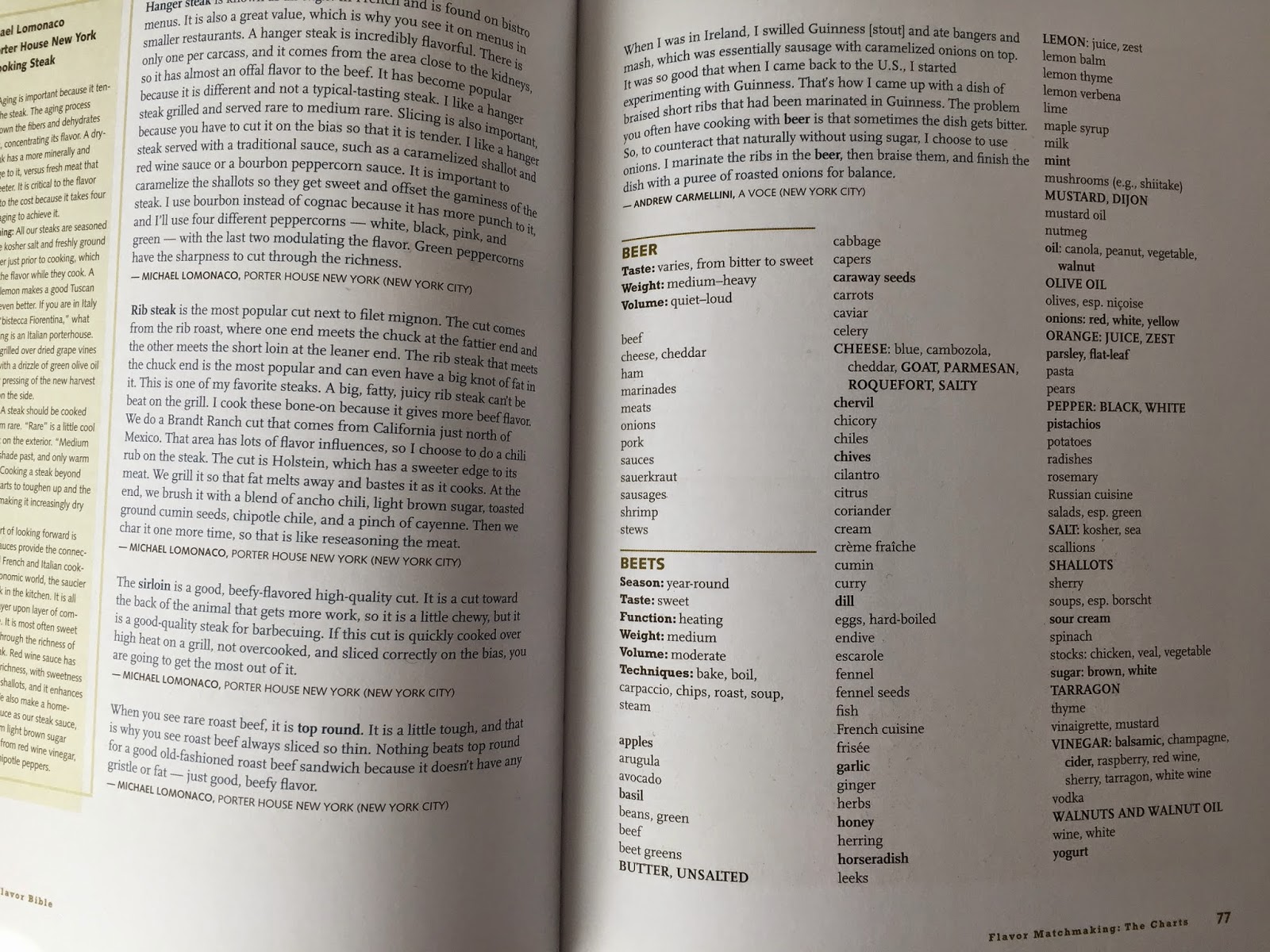| Honey-Mustard-Orange Roasted Beet Salad with Chickpea, Halloumi, Walnut and Spinach |
I finally received a long-awaited book in the mail from Amazon. The Flavor Bible by Karen Page and Andrew Dornenberg was the worthy recipient of the 2009 James Beard Book Award and I’d been eyeing the book for a long time.
The beauty of this book is that it is not about directions and formulas and recipes; it’s about making you more creative in the kitchen. It’s an impressive work of research and scholarship: Eight years in the making, the book is a guide through hundreds of main ingredients and spices, giving you wisdom and tips and experience from a vast variety of food experts on what ingredients to pair together in order to make magic in the kitchen.
 |
| The Flavor Bible |
Perhaps you, like me, have been at the grocery store or farmer’s market and have picked up an ingredient the is a bit unfamiliar or with which you haven’t cooked before. The food looks beautiful, enticing: you decide to go ahead and buy it and take it home with you. It sits on the counter or in the fridge, waiting. Every now and again, you pick it up and wonder: how do you use this? What do I use it with? Do I cook it or eat it raw? What will bring out the best of its flavor.
I have been there many, many times. And I often get the question “what you do with x ingredient?” This is the book with answers to those questions.
As you open up the pages, your creative juices will immediately begin to flow: what are the role of the individual tastes of sweet, sour, bitter and salty? Which ingredients work best together? What is the role of acid in the food I’m making? How do I get a deeper, more satisfying flavor by combining various ingredients? What are some new ways I can incorporate herbs and spices into my food?
The main ingredient I wanted to play with when I opened the book was the humble beet. It’s a food I’ve been familiar with for years, but only learned to love one fine evening in 2008 in Gothenburg, Sweden when my colleague and I ordered the beet appetizer before our meal. I ordered it more out of curiosity than anything; my parents had grown beets, but they and my older sister were the only ones to like them as far as I remember – the rest of us ran as far away as we could get when the beets arrived at the table. We were completely unimpressed. Beets in my experience up until that day in Gothenburg came in two forms: boiled or pickled. The former was slightly more palatable than the latter; nevertheless it wasn’t a food that held any memories of joy for me. Nope. I never craved beets nor thought about them at all.
A main ingredient in successful travel is the willingness to try something new – to challenge your own assumptions and reservations for the possibility of falling in love with some aspect of life or culture…or way of cooking…you’d never dreamed of. And so we placed our order and the humble beet arrived at my table, roasted & caramelized, drizzled lightly with olive oil, and topped with a portion of goat cheese that had been baked just long enough to turn the top a beautiful, golden brown. It was a beautiful combination, and I’ve made varieties on that them of beet + goat cheese many times since. Please try this at home.
 |
| Beets, p. 77 |
Looking at my bag of unassuming beets, I was ready for something new. As my eye ran down page 77, where BEETS fell in line directly after BEER, I took in the basics about them:
Season: year-round
Taste: sweet
Function: heating
Weight: medium
Volume: moderate
Techniques: bake, boil, carpaccio, chips, roast, soup, steam (note: no mention of pickling)
I’d already decided to roast them; the question was with what. Following an overview like the one above for each ingredient in the book is list of compatible ingredients. They are listed in plain text (for works OK); bold text (works well), and BOLD CAPS (an outstanding partner).
And here’s what caught my eye: CHEESE, blue, cambozola, cheddar, GOAT, PARMESAN, ROQUEFORT, SALTY; honey; LEMON: juice, zest; MUSTARD, DIJON; OLIVE OIL; ORANGE: JUICE AND ZEST; PEPPER: BLACK, WHITE; SALT: kosher, sea; spinach; WALNUTS AND WALNUT OIL.
I started to grin. This was going to be fun.
And it was – fully enjoyable to take a list of ingredients that someone else had already tested and believes works well together and use them as a guideline to create something brand new – at least to me. The resulting warm salad is both beautiful to look at and satisfying to eat – marrying a variety of flavors into a single dish that pleases all the senses.
Try this recipe, and then take a look at the book yourself – my guess is you’ll end up surprising yourself with what you come up with – I sure did.
Honey-Mustard-Orange Roasted Beets, Chickpea, Halloumi, Walnut and Spinach Salad
5 large beets, scrubbed clean, tops and tails cut away
zest of one organic orange
1 teaspoon mustard, preferably Dijon
1 teaspoon honey
1/2 teaspoon salt
1/4 teaspoon freshly ground black pepper
juice of one lemon
1 tablespoon olive oil
1 cup cooked chickpeas
1 cup spinach, washed
150 g Halloumi, cut into bite-size pieces
handful of walnuts, lightly chopped
Preheat the oven to 200°C/400°F.
Cut the beets into 5 slices; then cut each slice into thirds. Combine the orange zest, mustard, honey (melt in the microwave if it is the firm variety), salt, pepper and lemon juice in a small bowl and whisk well to combine to make a dressing. Add the beets and toss well to cover the beets thoroughly with the dressing. Pour the dressed beets and all of any liquid from the bowl onto a parchment-lined baking sheet. Bake 30-40 minutes, or until the beets can be easily pierced with a fork and are beginning to brown around the edges. Remove from oven.
While the beets cook, supreme the orange: Cut off the top and bottom of the orange and place it on the cutting board with one cut side down. Cut the peel away from the orange, including the white pith, using curving slices from top to bottom so that you see only the flesh of the orange. Take the orange into the palm of your hand, place a small bowl in front of you, and using a paring knife, carefully cut the segments of oranges from between the orange membranes and into the bowl. When you have cut out all the segments, squeeze what is left of the orange over the bowl to extract all the juices.
Put the chickpeas and their liquid into a small pot and warm them until the liquid just begins to bubble. Turn off the heat. (If you don’t have any of the chickpea liquid, add water to just cover the chickpeas instead)
Once the beets are ready and out of the oven, place a frying pan on the stovetop and heat to medium high. Pour in the walnut pieces and stir and toss until the walnuts just begin to brown; about 2 minutes. Pour the walnuts onto a plate to cool slightly. Put the pan back on the stove. Add the halloumi pieces and fry them on both sides until they are golden brown. Remove the halloumi from the pan to a plate. Put the washed spinach into the hot pan and cook briefly, about 60 seconds, until it just begins to wilt. Turn off the pan.
To assemble:
Arrange the beet slices evenly on four plates. Divide the chickpeas evenly between the four plates. Sprinkle and equal amount of the wilted spinach over each plate. Divide the halloumi between the four plates. Arrange a few orange slices on top of each salad and sprinkle with a few of the walnuts. Finish the salads by drizzling any remaining orange juice over the top of each plate and adding a drizzle of olive oil. Alternatively, you can arrange all of the ingredients on a serving platter, layering them as indicated above.
Serves 4.